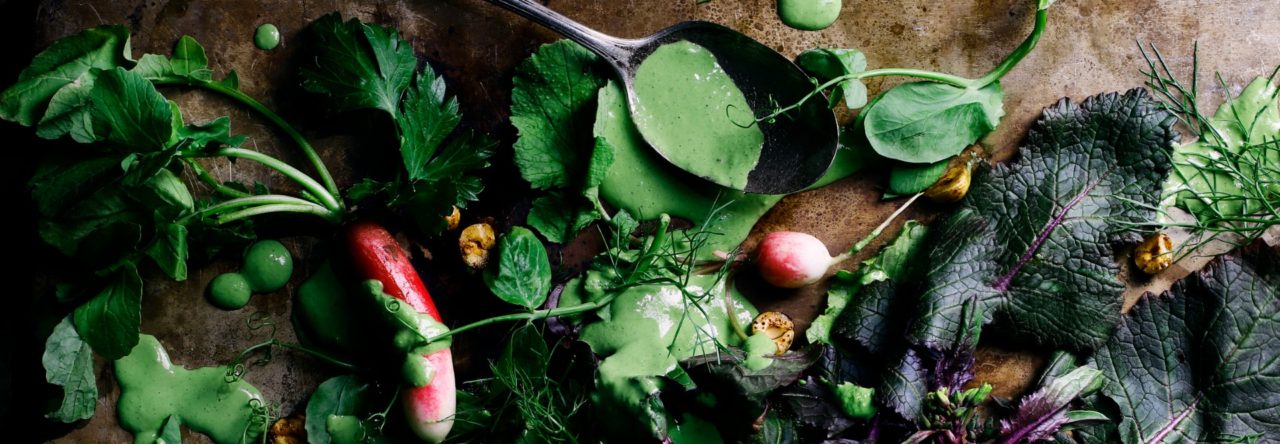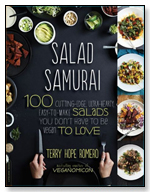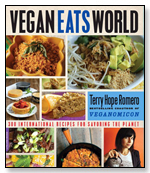A Drunken Noodle Saga (Pad Kee Mao)
Serves 2 to 3
There are many colorful stories about the origins of this addictive Thai spicy noodle dish, but the strangest one maybe be the wife so fed up with the grousings of her drunken husband she loaded his favorite noodles with enough hot chile peppers to set him straight. If he wasn’t drunk enough already, the heady mixture of savory Thai sauces and handfuls of fiery chiles would be enough to make him swoon and buckle. Your homemade spin on this restaurant favorite doesn’t have to be as punishingly hot, and you may even find this (and Pad See Ew) preferable and easier to make than Pad Thai.
Like her sister recipe Pad Se Yew, Pad Kee Mao requires that unique magic that only genuine Thai soy sauces can deliver. Regular supermarket Chinese or natural store Japanese-style sauces just don’t taste right; while your dish may be tasty, it won’t taste like Thai food. Thai thin (or light or white) soy sauce (which is not low sodium but has a light amber color, thin consistency and strong salty taste) does a nice job at standing in for fish sauce. Golden Mountain sauce is a special Thai seasoning sauce with a consistency and flavor slightly like Worcestershire sauce; it’s vegan and has a complex range of flavors that soy sauce alone does not cover. Thai black soy sauce and sweet soy sauce are two thick, dark and sweet sauces rich with caramel and molasses-like notes. Authentic Thai vegetables are much more challenging to find than the sauces, but a little cabbage, carrot or even a few florets of broccoli or a handful of snowpeas do the trick. About the only thing I don’t love adding to this dish are bell peppers, and the ample amount of fresh hot chiles should supply enough pepper activity.
Regarding the rice noodles, you have license to use whatever you can find. Many Thai restaurants use slippery, chewy wide fresh rice noodles for both this and Pad Se Yew. These noodles are delicious and will make the most authentic-tasting dish, but also can be difficult to find. Regular Pad Thai rice sticks are an easy to locate substitute. You could even make this all vegetable if you wanted to skip the noodles all together, serving with a mount of hot jasmine rice.
Cooking tip:
Like many stir fry noodle dishes, this is best prepared in batches instead of one big wok full of stuff.
Divide the ingredients and the sauce into two or even three separate batches; the stir fry portion of the recipe is fast so it really isn’t too much trouble. This will insure the ingredients in the wok cook at a super hot temperature for that tasty seared quality for the noodles and veggies. Rinse the wok with hot water (but no soap), give it a quick scrub with a bamboo brush and heat on the stove to evaporate any water droplets before making the next batch.
Ingredient tip:
Look for Thai sauces like Golden Mountain, Thai light (also called thin or white) soy sauce and black and sweet soy sauces not only in Thai groceries but in large, well stocked Chinese and Pan-Asian grocery stores in the bottle sauces isle. The most common brands are Healthy Boy and Golden Mountain.
Flat, fresh rice noodles can be elusive; these soft, slippery noodles will make these dishes taste like the real thing. If you can’t find sliced, fresh flat rice noodles at Thai markets, investigate Chinese markets for bags of soft fresh rice ho fun noodles. These are remarkablely fun to work with, basically being one huge rice noodle that’s folded several times like a floppy dish towel.
Ho fun noodles typically become very stiff when refrigerated (but uncooked keep for a long time). To refresh ho fun noodles, either steam for 3 to 5 minutes until soft enough to unfold or add to boiling water for 3 to 4 minutes or until pliable, drain and cover with cool water until ready to use. Watch carefully and don’t overcook. From here you can unfold the super noodle (if it rips a little don’t worry), and slice into wide 2 inch ribbons. Or I usually just tear the noodle with my fingers into 3 inch wide pieces. Either way they’ll taste perfect once doused with sauces and stir fried to perfection.
Drunken Noodle Sauce
- 2 tablespoons Chinese vegetarian stir fry sauce
- 2 tablespoons Thai thin soy sauce
- 4 teaspoons brown sugar or palm sugar
- 1 tablespoon Golden Mountain sauce
- 1 tablespoon Thai black soy sauce or Thai sweet soy sauce
- 2 teaspoons rice vinegar
- 2 teaspoons lime juice
- 2 to 3 teaspoons Asian chile garlic sauce or red pepper flakes
Noodles and vegetables:
- 12 ounces Thai fresh flat rice noodles or Chinese fresh ho fun
- 3 tablespoons peanut, canola or grapeseed oil, divided
- 8 ounce package fried tofu or 1 recipe Pressed Baked Tofu, sliced into 1/4 inch thin pieces
- 5 cloves garlic, roughly chopped
- 3 to 4 red or green hot chile peppers (Thai, Indian or serranos), sliced into paper thin rings
- 3 cups shredded Napa or Savoy cabbage
- 3 scallions, ends trimmed and thinly sliced
- 1 carrot, sliced into thin shreds
- 1/2 cup lightly packed Thai basil leaves
- 1/2 cup lightly packed cilantro leaves
1. If your rice noodles are very fresh and still soft, you don’t need to cook them. If already sliced, gently separate the noodles and set aside, or re-fold the ho fun several times into a wide tube and slice into wide 2 to 3 inch strips. If the noodles have been refrigerated and are hard, set up a bamboo or metal steamer over boiling water. Steam the Thai noodles or the whole, unsliced ho fun until soft (3 to 5 minutes), then turn off the heat and keep covered. If using ho fu, when the noodle is cool enough to handle either slice into strips or tear into pieces about 2 or 3 inches wide with your fingers. Keep covered until ready to use.
2. In a liquid measuring cup whisk together the vegetarian stir fry sauce, Thai light soy sauce, brown sugar, Golden Mountain sauce, black or sweet soy sauce, rice vinegar, lime juice and chile sauce. Chop the vegetables and arrange all of the ingredients within easy reach of the stove for the stir fry.
3. Preheat a wok or large skillet over high heat, then pour in the 1 tablespoon of the oil. When the oil is rippling, stir in the garlic and chiles stir fry for 1 minute, add the tofu and fry another 2 to 3 minutes until the tofu browns on the edges. Transfer the tofu to a dinner plate. Add another tablespoon of oil and add carrot and cabbage and fry for 2 minutes until slightly softened. Transfer to the plate with the tofu.
4. Add the remaining tablespoon of oil, add the noodles and stir fry for 1 minute. If the noodles start to stick, dribble in a teaspoon or two of water; whenever sticking starts to happen add a little water but don’t add too much or the noodles will become mushy. Now drizzle on half of the sauce, stir fry for 2 minutes and add the tofu and cabbage and the remaining sauce. Stir in the basil leaves and cilantro. Continue to stir fry for another 1 to 2 minutes or until most of the liquid has been absorbed, everything is coated in sauce and the noodles are gently seared in some places. Transfer immediately to serving plates and serve with additional lime wedges for sprinkling.
Variation with Pad Thai rice sticks
Prepare an 8 ounce package of pad thai rice sticks as directed for Avocado Pad Thai, keeping them stored in water until ready to use. Drain and use as directed for fresh rice noodles.
Other stir fry ingredients:
-Stir in 2 to 3 teaspoons of fresh green peppercorns along with the chiles
-Slice a large shallot into paper-thin slices and fry along with the garlic and chiles until golden
-Add a handful of snow peas, baby corn or thinly sliced broccoli along with the cabbage
-Omit the noodles and double the amount of vegetables








